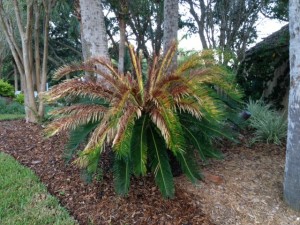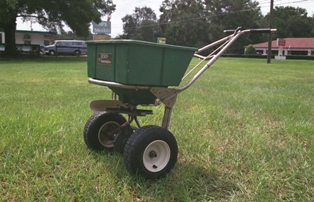by Mary Salinas | Sep 23, 2013
Is the newest growth on your sago palm turning yellow, brown, frizzy looking and dying – is it a pest or disease or something else?

Photo credit: Mary Derrick
This sago palm is suffering from a classic case of manganese deficiency. When sago palms lack manganese, the newest leaves will develop yellow splotches or be entirely yellow. As the leaves die, they turn brown and take on a frizzled appearance. Sometimes the leaves or fruit may be smaller than normal. If left unchecked, the sago usually dies.
Manganese is a micronutrient required by all plants for normal, healthy growth and is most available for plant uptake when the soil pH is between 5.5 and 6.5. Soils in the Florida panhandle are often naturally low in manganese and then what available manganese is present can be unavailable for the plant to use if the pH of the soil is much above 6.5. Also, manganese tends to be leached from the soil when the pH is below 5.5. Soil pH and nutrient testing is useful to determine if soils are nutrient deficient. Contact your county Extension office for information on getting that done.
[notice]Before treating, rule out an infestation of Asian cycad scale. Click here for a UF IFAS Extension publication on this damaging insect. Be aware that both are common problems for sago palms and that your sago may be afflicted with both![/notice]
If this is happening to a sago palm, the good news is that it is easy to correct. Manganese sulfate is readily available at garden centers, feed &seed stores and independent nurseries. Just make sure to get manganese sulfate and don’t confuse it with magnesium sulfate (Epson salts). The amount of manganese sulfate necessary to correct this deficiency will vary with its size, soil type and pH. Sago palms in sandy, acidic soils require less manganese sulfate than those in high pH soils. One ounce is sufficient for a very small plant in sandy, acidic soil. A very large sago in a high pH soil may require about five pounds, however. Spread the product evenly over the root zone and water in with about a half inch of water.
The affected leaves cannot be cured but new growth should return to normal. If the new growth is still affected, an additional application of manganese sulfate may be needed. Once sago palms have suffered from a manganese deficiency, half the initial rate should be applied yearly to prevent the deficiency from re-occurring.
Even though sago palms are not true palms – they are cycads – their nutritional needs are very similar to palms. Most of the time they grow well without any supplemental fertilization, but if they do need fertilizing, use a 8-2-12-4 (the fourth number is magnesium) palm fertilizer with micronutrients and avoid using other fertilizer products in their root zones.
For more information on sago palms please see:
Cycas revoluta, Sago Palm
by Julie McConnell | Sep 9, 2013

Fertilizer Spreader: Image Courtesy UF / IFAS Extension FYN Program
Although temperatures are still hovering around 90° F, the last fall fertilization date is approaching quickly. Mid-September is the
deadline for applying fertilizer to warm season turf-grasses and landscape ornamental plants for the year. Why is September 15 the cutoff date? In North Florida, our estimated first frost date is November 15. When fertilizer is applied the nutrients encourage new growth that typically takes about 6-8 weeks to become “hardened off” and able to tolerate low or freezing temperatures. So, simply backtracking on the calendar gives you an idea of when to make the last application of fertilizer (if needed).
If September 15 is at the end of our warm season feeding schedule, the next question should be “when should I fertilize in the spring?” Although Northwest Florida’s average last frost date is listed as March 15, UF/IFAS Turf Specialist Dr. Bryan Unruh does not recommend fertilizing before April 15 in the panhandle. There are two main reasons for this later date. One is that the March 15 last frost date is an estimate, many times cold weather follows a warming trend in late winter/early spring. During April of this year warm weather was followed by cool temperatures with cold winds that caused landscape plant damage. If fertilizer was applied before this weather arrived, some cold damage may have been evident this spring in affected landscapes. The second reason is that if fertilizer is applied to turf or plants that are not actively growing and using those nutrients, it may leach out of our sandy soils. Nutrients do not wait for plants to use them; they can be washed out and become a source of nonpoint source pollution.
To read more tips on fertilizing visit EDIS ENH1174 “The Lawn Fertilizer Toolbox”

by Blake Thaxton | Jun 4, 2013

As of January 2014 all companies applying fertilizer, commercially “for hire”, will be required to hold a fertilizer applicators license. In order to obtain this license you must first become GI-BMP certified.
2014 isn’t that far away. Take the time to attend class this summer. Don’t wait to the last minute and have to scramble to find a training close to home.
What are Green Industries Best Management Practices?
GI-BMPs teach environmentally safe landscaping practices that help conserve and protect Florida’s
ground and surface waters and natural resources. This science-based educational program for
Green Industry professionals is brought to you by the UF/IFAS Florida-Friendly LandscapingTM
program and the Florida Department of Environmental Protection. Other FAQs about GI-BMPs
June 28th – Santa Rosa County
Navarre Community Center: 1917 Navarre School Rd Navarre, FL 32566
For more information email Blake Thaxton at bthaxton@ufl.edu




